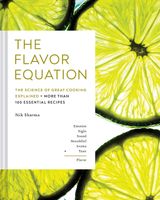Advertisement
How Aromas Work
Appears in
By Nik Sharma
Published 2020
Our ability to smell is one of the most powerful senses we’re gifted with. This ability can warn us of impending danger when we smell smoke from a burning fire or the risk of sickness when we detect the putrid smell of rancid butter. It helps us build familial bonds as a baby learns its parents’ scents. It can also entice and make us hungry when we smell the perfume of rosewater and cardamom mingled with coconut in a cake (see Coconut Milk Cake).
When we inhale, aroma molecules travel through air to the cells lining the back of the nose—the olfactory epithelium. Here these molecules dissolve and interact with the odor receptors, which send an electric signal to the brain. We have more than four hundred different types of odor receptors that can detect more than one trillion types of aromas at extremely low quantities (in a tiny number of parts per billion). How does this work? A single aroma molecule can bind more than one type of odor receptor, and a single type of odor receptor can bind more than several different types of aroma molecules. As a result, we can detect a variety of combinations of aroma molecules, which helps us discriminate among the various aromas of the foods we eat.

